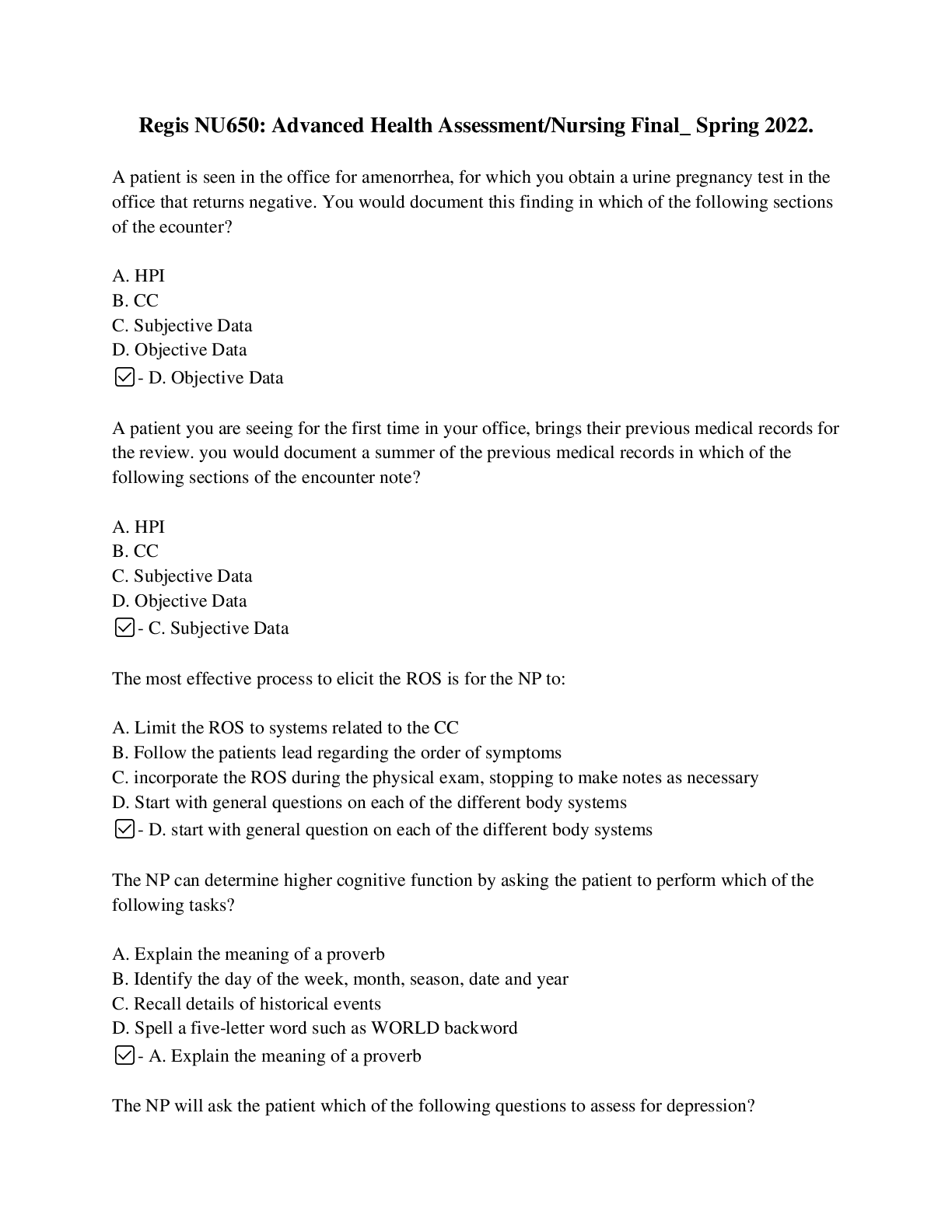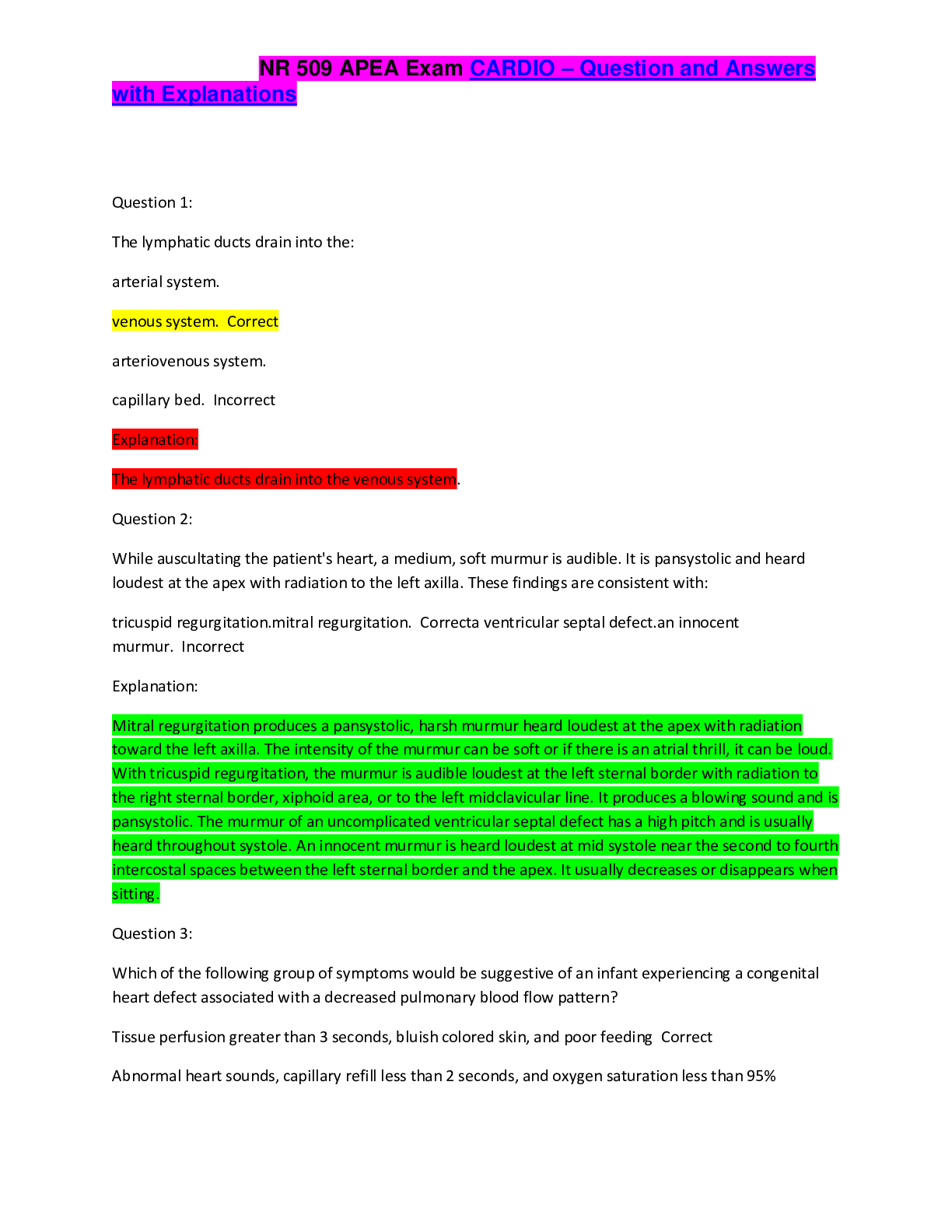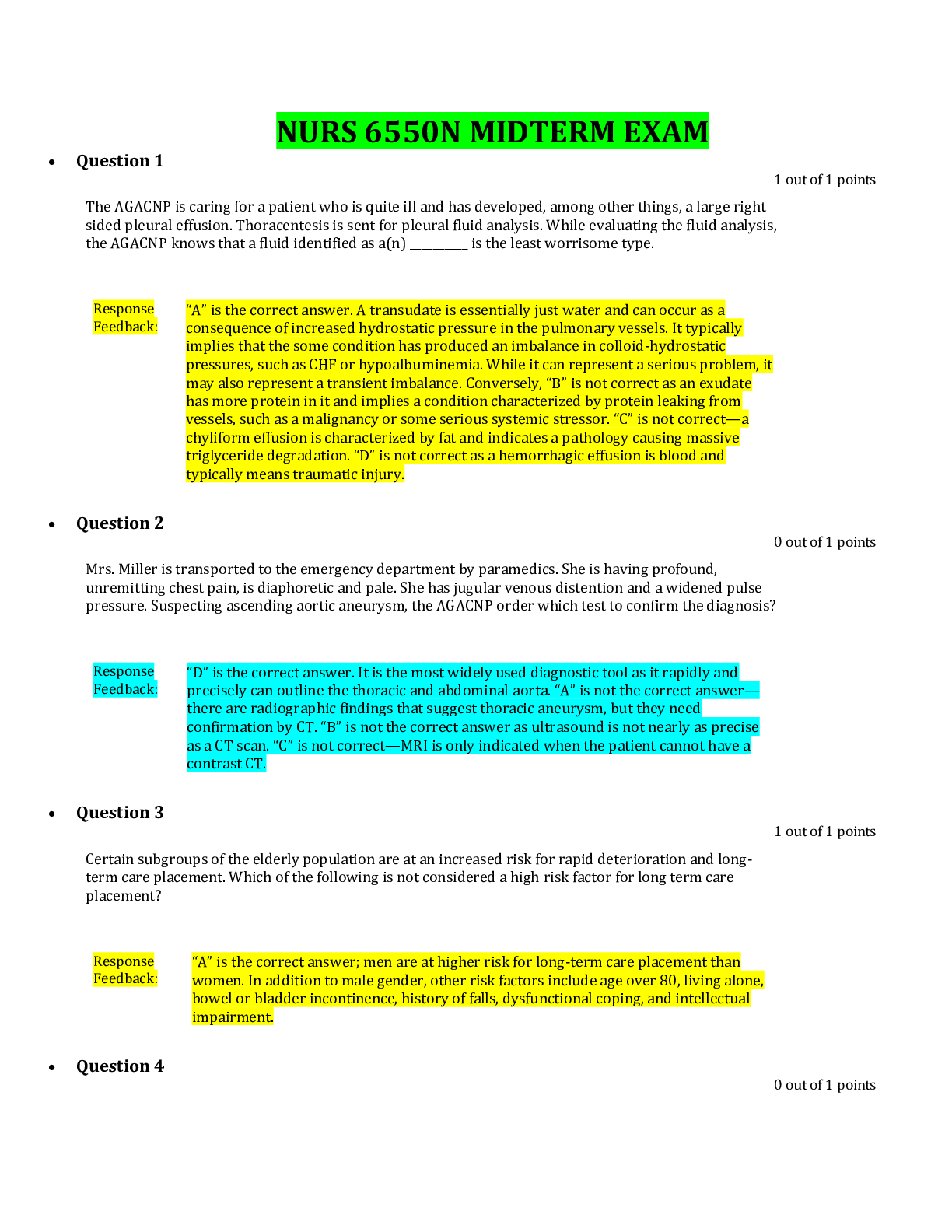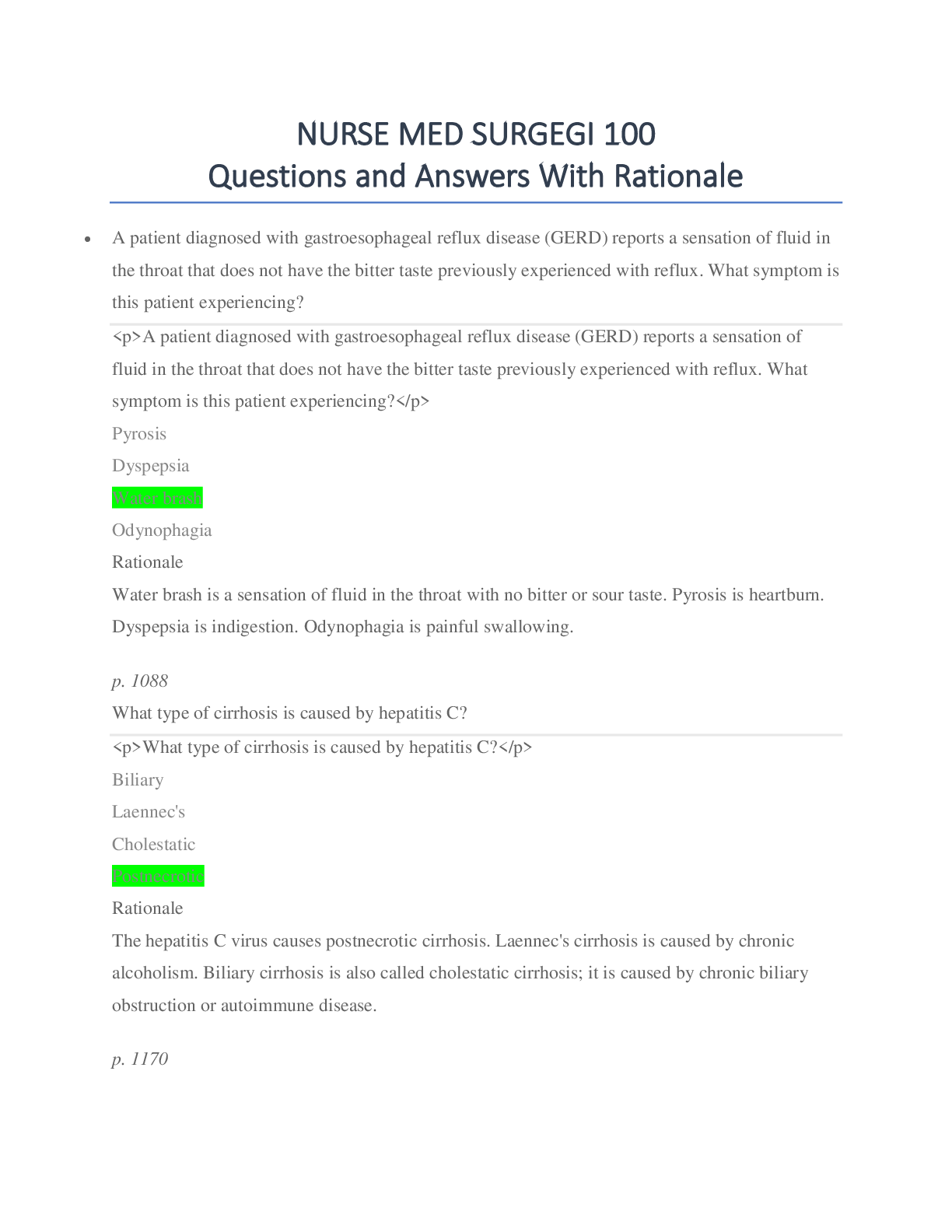*NURSING > EXAM > American River College: BSN 346 (BSN246) Intravenous Therapy Exam| Complete Questions and Answers wi (All)
American River College: BSN 346 (BSN246) Intravenous Therapy Exam| Complete Questions and Answers with Rationales | Updated 2025/26.
Document Content and Description Below
Question 1 1 / 1 pts Question 2 1 / 1 pts LATEST 2025 Score for this quiz: 15.6 out of 16 A 4-year-old child was recently admitted to the hospital and has orders for an intravenous (IV) line to be sta... rted. Which of the following is an acceptable IV insertion site for a child? The antecubital space. The scalp. Ventral surface of the wrist. The forearm. The nurse is informing the patient of actions that may be taken to promote venous distention. Which statement, if made by the patient, indicates further instruction is needed? (Select all that apply.) "I need to keep my arm elevated for 10 to 20 minutes." "I've seen other nurse's tap the vein multiple times, maybe that will work." "You'll come back in a few minutes while I keep this warm towel on my arm."Question 3 1 / 1 pts Question 4 0.6 / 1 pts The nursing instructor has been observing nursing students initiate an IV infusion. Which action(s), if made by the nursing student, indicate(s) that further instruction is needed? (Select all that apply.) The nursing student: Performs hand hygiene, spikes the bag of fluids, primes the tubing removing all air bubbles, replaces the cap on the end of the tubing, applies the tourniquet and identifies an accessible vein, removes the tourniquet, applies gloves, and cleans the site in preparation for venipuncture. Removes gloves to tape and apply the transparent dressing over the intravenous site. Tapes tubing to transparent dressing. Cleans the insertion site with chlorhexidine solution in a back-and-forth motion for 30 seconds; allows the area to dry; then, while wearing gloves, palpates the vein before inserting the catheter at a 10- to 30-degree angle. Applies the tourniquet, cleans the site, allows it to dry, performs the venipuncture, looks for blood return, advances the catheter of f the stylet, applies pressure above the insertion site, connects the tubing, starts the infusion, and releases the tourniquet. Which of the following situations indicates peripheral IV access could be discontinued (provided the health care provider has given the corresponding order)? (Select all that apply.) The patient: Is complaining of pain at the IV site and there is absence of a blood return. Has completed the course of IV antibiotics and the intravenous access device is unnecessary. Receives all regularly scheduled medications by mouth and has prn orders for medications administered intravenously.Is being discharged to home on oral (PO) meds. Is NPO until nausea is resolved. Has an arm that is swollen and cool to the touch and complains of pain at the IV site. Who has been receiving IV fluids for fluid maintenance is drinking fluids well and electrolytes are within normal limits.Question 6 1 / 1 pts The nurse is preparing to document insertion of the IV in accordance with the health care provider's orders for normal saline at 100 mL per hour. Which of the following should the nurse include in documentation of the procedure? (Select all that apply.) When infusion was begun and at what rate. Number of attempts at insertion. Phlebitis scale rating. Size and type of catheter or needle. Type of fluid. Expected time to hang next IV bag or bottle. Location of insertion site. Patient's response. Question 5 1 / 1 ptsQuestion 7 1 / 1 pts A 4-year-old child was recently admitted to the hospital with orders for an IV to be started. The nurse prepares the IV infusion and primes the tubing, applies a tourniquet, selects a vein in the antecubital space, releases the tourniquet, applies gloves and cleans the site with chlorhexidine, reapplies the tourniquet, performs the venipuncture, obtains a blood return, advances the 24-gauge catheter off the stylet, applies pressure above the insertion site, releases the tourniquet, connects the tubing, and begins the infusion. The nurse then secures the catheter with tape and a dressing, adjusts the flow rate, and labels the dressing. Which action made by the nurse was incorrect? Site selection. The nurse was correct in all actions. Use of a 24-gauge catheter. Timing of beginning the infusion. Use of chlorhexidine to cleanse the site. Use of a tourniquet. A 48-year-old man has to have his IV restarted. It is currently located in his left lower forearm. He has a history of renal failure and has a shunt locatedQuestion 8 1 / 1 pts in his right arm for dialysis. Which of the following is an appropriate site for IV relocation? Either foot. The right hand. Distal to the previous IV site on the left arm. The left hand where there is a prominent hardened cordlike vein. The left arm, proximal to the previous IV site. The dorsal left wrist where the veins bifurcate. The right arm. The student nurse is preparing to initiate an IV on a 36-year-old patient who is to receive an IV infusion for fluid maintenance. At this time, surgery is unanticipated. Which size catheter should the nursing student select? 24- or 26-gauge. Butterfly needle.Question 9 1 / 1 pts Question 10 1 / 1 pts 18-gauge. A variety of sizes because the weight of the patient is unknown. 22-gauge. Upon discontinuing peripheral intravenous access, the nurse notes the catheter tip is missing. What action should the nurse take? Notify the health care provider immediately. Cover the site with a pressure dressing. Apply a warm compress to the extremity. Apply ice to the insertion site. The nurse is performing a routine physical assessment on a patient with heart failure. The nurse finds the following data: Patient is alert and oriented,Question 11 1 / 1 pts face flushed, lung sounds with rhonchi, respirations slightly labored at a rate of 28, heart rate 98, blood pressure 140 over 92, abdomen soft with bowel sounds present, clear yellow urine in bedside drainage bag of Foley catheter, and +2 edema of lower extremities. The patient has an IV of normal saline infusing at 125 mL per hour in the left forearm without redness at the IV site. The patient denies any complaints of pain. The nurse discontinues the IV, notifies the health care provider, raises the head of the bed, and monitors the patient's vital signs. Which of these nursing actions is wrong? Raising the head of the bed. Discontinuing the IV. Notifying the health care provider. Monitoring the patient's vital signs. The nurse is preparing the IV for infusion. The nurse has checked the IV solution using the six rights of medication administration. The nurse checked the solution for clarity and expiration date. Which of the following steps, if performed by the nurse, require correction? The nurse checks the length of tubing and the drip chamber to make sure that both are filled with fluid and that no air is remaining. The nurse removes the protective sheath over the IV tubing port on the IV bag and on the insertion spike of the tubing. Without touching the spike, the nurse inserts it into the tubing port of the IV and primes the infusion tubing with IV solution.Question 12 1 / 1 pts Question 13 1 / 1 pts Which of the following IV solutions would be infused for the patient who has been vomiting and is requiring fluid replacement? D5NS D5LR 0.45% sodium chloride 0.9% sodium chloride . A trauma patient is received in the emergency room. Which size catheter should the nurse select to initiate the IV? 22-gauge. 22- to 24-gauge. Butterfly needle.Question 14 1 / 1 pts Question 15 1 / 1 pts 18-gauge. Which of the following would be an appropriate site for placement of an IV? Distal to the previous site as long as the vein does not appear red. The patient’s nondominant forearm. The arm on the same side of a mastectomy. The flaccid arm of a patient who previously experienced a cerebrovascular accident (stroke). In which of the following situations would it be acceptable to allow the IV infusion (IV access) to continue? Swelling above the insertion site and cool temperature. Redness, tenderness, and warmth and palpable cord at IV site. IV is infusing but at a slower rate than ordered.Question 16 1 / 1 pts IV fluid container empties with subsequent loss of IV line patency. Which of the following actions fail to follow practices of infection control, therefore placing either the nurse or patient at risk? (Select all that apply.) The nurse replaces the peripheral venous catheter and rotates the site every 96 hours or immediately when complications appear. The nurse uses a needle when aspirating for a blood return to assess for patency. The nurse does not palpate the insertion site after the skin has been cleansed. Unable to obtain a flashback of blood, the nurse withdraws the catheter and needle and reinserts it at a deeper angle. [Show More]
Last updated: 2 hours ago
Preview 4 out of 11 pages

Loading document previews ...
Buy this document to get the full access instantly
Instant Download Access after purchase
Buy NowInstant download
We Accept:

Reviews( 0 )
$13.50
Can't find what you want? Try our AI powered Search
Document information
Connected school, study & course
About the document
Uploaded On
Sep 16, 2025
Number of pages
11
Written in
Additional information
This document has been written for:
Uploaded
Sep 16, 2025
Downloads
0
Views
14


























